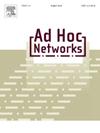A Q-learning-based trust model in underwater acoustic sensor networks (UASNs)
IF 4.8
3区 计算机科学
Q1 COMPUTER SCIENCE, INFORMATION SYSTEMS
引用次数: 0
Abstract
Underwater acoustic sensor networks (UASNs) play a pivotal role in various civil and military fields. However, due to their open nature, they are susceptible to multiple security threats. As such, developing robust and reliable security strategies is essential to ensure the normal operation of UASNs. This paper proposes a Q-learning-based trust model (QLTM) for UASNs. To detect hostile nodes, each underwater sensor node is required to collect trust evidence –namely energy trust evidence, data trust evidence, and communication trust evidence–through communication and interaction with its neighboring nodes. After gathering the trust evidence, QLTM presents a distributed Q-learning-based trust management model that adapts to dynamic underwater environments. It continuously updates the trust parameters based on ongoing interactions between the agent and the environment. The Q-learning-based trust management model includes a state set with three states: trust, distrust, and uncertain. Additionally, the reward function is calculated according to the gathered trust evidence, and the weight of each trust evidence is determined such that evidence with a lower value carries more weight, thus having a greater effect on the generated reward. Experimental results demonstrate the effectiveness of QLTM compared to other trust mechanisms, so that QLTM improves the detection accuracy rate by 5.04%. However, when the attack mode changes in the network, QLTM performs approximately 4.29% worse than TUMRL in detecting malicious nodes. On the other hand, QLTM reduces the false alarm rate by about 7.39% and increases energy efficiency by approximately 4.26%.
基于q学习的水声传感器网络信任模型
水声传感器网络在各种民用和军事领域发挥着举足轻重的作用。然而,由于它们的开放性,它们容易受到多种安全威胁。因此,制定稳健、可靠的安全策略是保证uasn正常运行的关键。提出了一种基于q学习的usns信任模型(QLTM)。为了探测敌方节点,每个水下传感器节点需要通过与相邻节点的通信和交互来收集信任证据,即能量信任证据、数据信任证据和通信信任证据。在收集信任证据后,QLTM提出了一种基于q学习的分布式、适应动态水下环境的信任管理模型。它基于代理和环境之间的持续交互不断地更新信任参数。基于q学习的信任管理模型包括一个由信任、不信任和不确定三种状态组成的状态集。此外,根据收集到的信任证据计算奖励函数,并确定每个信任证据的权重,值越低的证据权重越大,从而对生成的奖励影响越大。实验结果证明了QLTM与其他信任机制相比的有效性,QLTM将检测准确率提高了5.04%。但是,当网络中攻击方式发生变化时,QLTM检测恶意节点的性能比TUMRL差约4.29%。另一方面,QLTM降低了约7.39%的误报率,提高了约4.26%的能源效率。
本文章由计算机程序翻译,如有差异,请以英文原文为准。
求助全文
约1分钟内获得全文
求助全文
来源期刊

Ad Hoc Networks
工程技术-电信学
CiteScore
10.20
自引率
4.20%
发文量
131
审稿时长
4.8 months
期刊介绍:
The Ad Hoc Networks is an international and archival journal providing a publication vehicle for complete coverage of all topics of interest to those involved in ad hoc and sensor networking areas. The Ad Hoc Networks considers original, high quality and unpublished contributions addressing all aspects of ad hoc and sensor networks. Specific areas of interest include, but are not limited to:
Mobile and Wireless Ad Hoc Networks
Sensor Networks
Wireless Local and Personal Area Networks
Home Networks
Ad Hoc Networks of Autonomous Intelligent Systems
Novel Architectures for Ad Hoc and Sensor Networks
Self-organizing Network Architectures and Protocols
Transport Layer Protocols
Routing protocols (unicast, multicast, geocast, etc.)
Media Access Control Techniques
Error Control Schemes
Power-Aware, Low-Power and Energy-Efficient Designs
Synchronization and Scheduling Issues
Mobility Management
Mobility-Tolerant Communication Protocols
Location Tracking and Location-based Services
Resource and Information Management
Security and Fault-Tolerance Issues
Hardware and Software Platforms, Systems, and Testbeds
Experimental and Prototype Results
Quality-of-Service Issues
Cross-Layer Interactions
Scalability Issues
Performance Analysis and Simulation of Protocols.
 求助内容:
求助内容: 应助结果提醒方式:
应助结果提醒方式:


